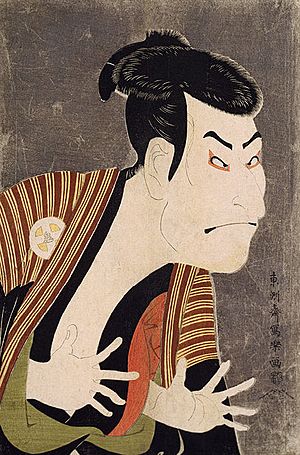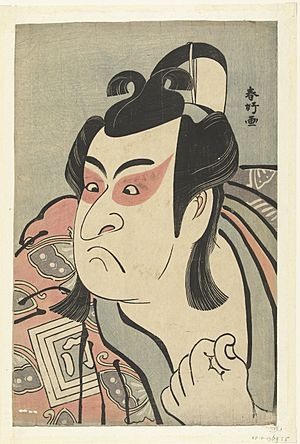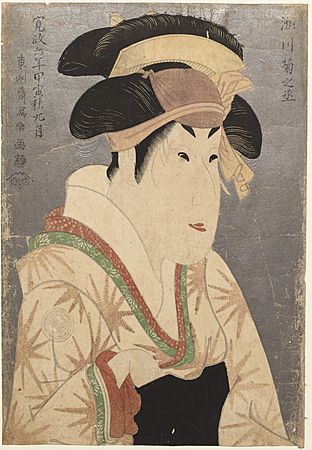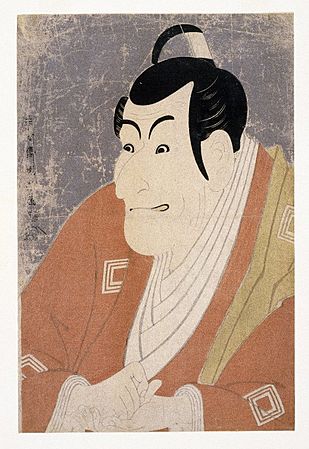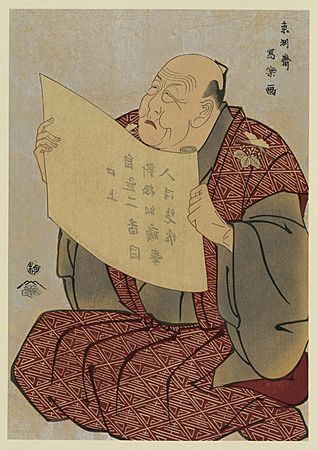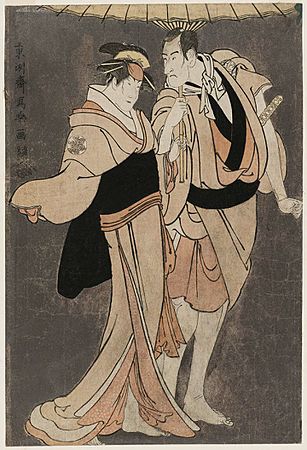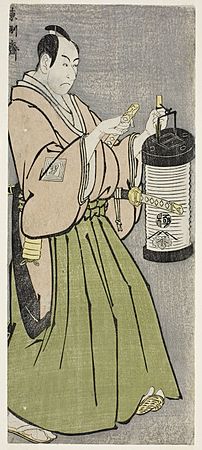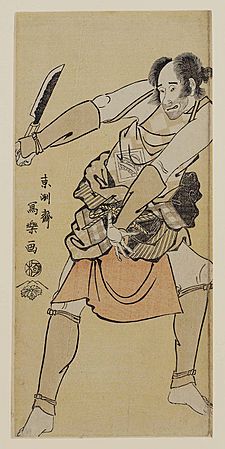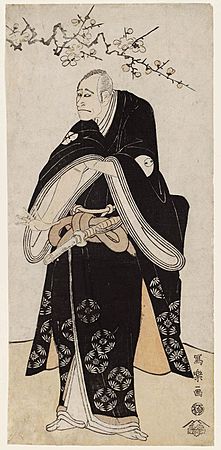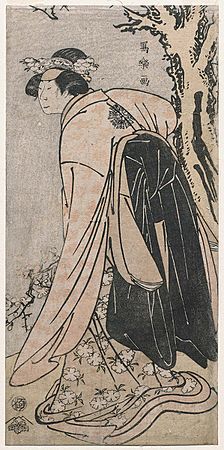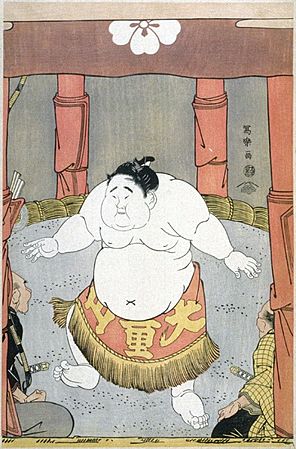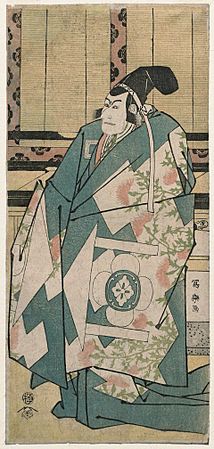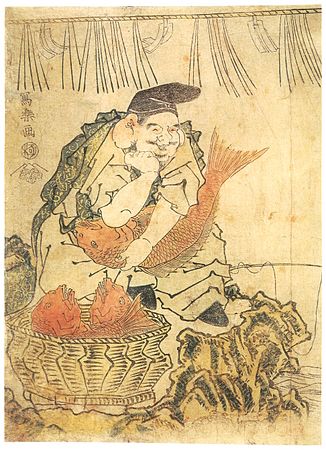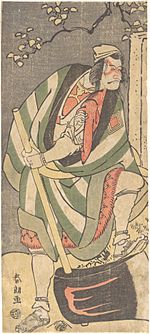Sharaku facts for kids
Tōshūsai Sharaku (Japanese: 東洲斎 写楽; active 1794–1795) was a mysterious Japanese artist. He was famous for his ukiyo-e prints, especially portraits of kabuki actors. We don't know his real name or when he was born or died.
Sharaku worked as a woodblock artist for only ten months. His art was very different from others at the time. He showed actors with lots of energy and a realistic look. Other artists, like Utamaro, made their subjects look perfectly beautiful. But Sharaku wasn't afraid to show details that weren't always pretty.
People back then didn't really like this style. So, his work suddenly stopped in early 1795. Even though he worked for a short time, his art is now seen as some of the best ukiyo-e. Many people have tried to guess who Sharaku really was. Some think he was a poet, a Noh actor, or even the famous artist Hokusai.
Contents
What is Ukiyo-e Art?
Art from the "Floating World"
Ukiyo-e art was popular in Japan from the 1600s to the 1800s. This art style focused on the "ukiyo" or "floating world" lifestyle. This included things like kabuki actors and people from the entertainment districts.
Ukiyo-e art was made for everyday people, especially merchants in Edo (which is now Tokyo). It was often printed using woodblock techniques. This made it easy to make many copies. Because it was for common people and mass-produced, it wasn't seen as "serious art" at the time.
New Styles in Actor Prints
After the mid-1700s, full-colour prints called nishiki-e became common. These prints used many woodblocks, one for each colour. The late 1700s are now seen as a very good time for this art.
An artist named Shunshō started making ōkubi-e prints in the 1760s. These were "large-headed pictures," often showing just the actor's head and shoulders. Shunshō and others made these ōkubi yakusha-e actor prints very popular. They even added shiny mica to the backgrounds to make them look fancy.
Earlier actor prints often used general features for actors. But these new ōkubi yakusha-e prints tried to show what the actors really looked like. People wanted to see the actual faces of their favourite performers.
Art During Tough Times
Sharaku's prints appeared during the Kansei era (1789–1801). This was a time when Japan faced economic problems. The government, called the shogunate, made strict rules to try and fix things. These rules, called the Kansei Reforms, limited fancy fashions.
Kabuki theatres also faced strict controls. Actors' incomes were limited. But even with these rules, art still thrived. New plays and popular actors kept appearing in kabuki theatre. People liked performances that felt more real. So, yakusha-e prints started to focus more on showing the unique look of each actor.
Sharaku's Artworks
Over 140 prints are known to be by Sharaku. Most of them are portraits of actors or scenes from kabuki plays. Some others show sumo wrestlers or warriors. His prints came in common sizes like aiban, hosoban, and ōban.
Sharaku's work is divided into four periods. The prints from the first two periods are signed "Tōshūsai Sharaku." The later ones are only signed "Sharaku." Over time, the print sizes became smaller. The focus also changed from close-up portraits to full-body pictures. The later prints are seen as less unique and more typical.
First Period Prints
The first period has 28 ōban prints from May 1794. These prints show actors from kabuki plays at three different theatres. These are "large-headed" actor prints with black mica backgrounds. They have clear, fine lines and simple colours. There are different versions of these early prints, which means they were printed many times and sold well.
- First-period kabuki portraits
Second Period Prints
The second period includes 8 ōban and 30 hosoban prints from July and August 1794. These prints show actors from various plays at the Miyako-za, Kawarazaki-za, and Kiri-za theatres.
Most of the ōban prints show two actors together. Only one ōban print shows a single actor's full body. Only one of these ōban prints uses a black mica background. The hosoban prints usually show a single actor's full body against a yellowish background.
- Second-period prints
Third Period Prints
The third period has 47 hosoban, 13 aiban, and 4 ōban prints from late 1794 to early 1795. These prints are from plays at the Miyako-za, Kiri-za, and Kawarazaki-za. There are also four prints of sumo wrestlers and two memorial prints for an actor.
By this time, the artistic quality of Sharaku's work had changed. It showed less of his unique style. Most of the hosoban prints in this period have backgrounds with trees or other stage scenery. This is different from his earlier works, which often had empty backgrounds. The aiban prints are more like his earlier style, focusing on the upper body and face against a plain yellowish background.
- Third-period prints
Fourth Period Prints
The fourth period includes 10 hosoban and 5 aiban prints from January 1795. These prints are from plays at the Kiri-za and Miyako-za. There is also one sumo print, two warrior prints, and one print of the god of luck, Ebisu.
- Fourth-period prints
Who Was Sharaku?
The Mystery of His Identity
Artists who made ukiyo-e prints usually didn't have a high social standing. So, we often don't have many personal details about them. But Sharaku is a very special case because almost nothing is known about him. People have searched for a long time but haven't found out who he really was. The mystery itself makes his prints even more interesting!
Many theories have been suggested, more than fifty! But only a few are taken seriously, and none have been widely accepted.
Different Ideas About Sharaku
Some old writings mention a poet named Sharaku. There's also a record from 1790 of a Katayama Sharaku in Osaka. Some people think Sharaku might have been from the Osaka area because his actor portraits look a bit like those by other Osaka artists.
There are also rare calendar prints from 1789 and 1790 signed "Sharakusai." Some wonder if these could be by Sharaku, but they don't look much like his other known works.
Many researchers believe Sharaku might have been a Noh actor. They found documents that suggest he worked for a lord in Awa Province. These documents also hint that Sharaku might have died between 1804 and 1807. One old paper even says he died on May 17, 1806, and was buried in a temple in Asakusa.
In 1968, a researcher named Tetsuji Yura suggested that Sharaku was actually Hokusai. Hokusai is famous for his landscapes, but he also made many actor portraits before Sharaku appeared. Hokusai often changed his artist name. It's possible he used a new name like Sharaku to avoid problems with government rules at the time.
Other ideas about Sharaku's identity include his publisher, other famous artists like Utamaro or Utagawa Toyokuni, or even that "Sharaku" was actually three different people! The mystery continues to this day.
See also
 In Spanish: Tōshūsai Sharaku para niños
In Spanish: Tōshūsai Sharaku para niños


